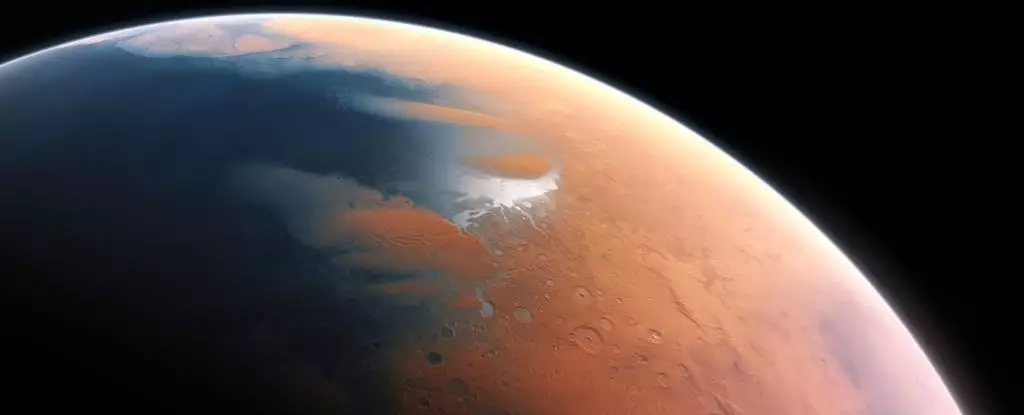Mars, the enigmatic red planet, has long fascinated scientists and stargazers alike. Once viewed as a dusty, desolate landscape, recent research is dramatically reshaping our understanding of Mars’ past. A groundbreaking study uncovered compelling evidence suggesting that Mars was home to vast bodies of water—potentially oceans—more than 4 billion years ago. Utilizing advanced ground-penetrating radar technology, researchers have found geological features resembling ancient beaches, hinting at a once-thriving aquatic environment on the planet.
Geologist Benjamin Cardenas from The Pennsylvania State University remarked on these findings, noting the unmistakable signs of an ancient Martian coastline, complete with beaches and river deltas. This discovery invites us to reimagine Mars not as a barren rock but as a vibrant world, possibly teeming with life in its prime. But this raises critical questions—what happened to all that water, and how did Mars transition from a hospitable, aquatic environment to the arid, inhospitable desert we see today?
Signs of a Lost Ocean: Evidence from the Red Planet’s Surface
The study in question utilized data gathered by the Zhurong Mars rover from the Chinese National Space Administration (CNSA). This sophisticated rover employed ground-penetrating radar (GPR) to send powerful radio waves into the Martian surface, penetrating up to 80 meters deep. When these waves encountered various subterranean features, they returned with signals that crafted a 3D map of Mars’ hidden geological structures.
Previous research hinted at shore-like formations, but this new analysis provided stronger validation. The GPR data unveiled thick layers of sediment sloping towards what scientists now believe to be an ancient shoreline, mirroring the geological attributes of terrestrial beaches. According to geophysicist Michael Manga from the University of California, Berkeley, these geological structures suggest an expansive, liquid ocean sustained by sediment-laden rivers and the forces of waves and tides.
The orientation and slope of these formations strengthen the case for an ecological environment supporting a water cycle—something that parallels conditions for beach formation on Earth. This notion posits that Mars could have harbored oceans that shaped its surface over eons, hinting at rich geological and potentially biological processes.
The implications of these findings are profound. If significant bodies of water existed on Mars, they could have created unique habitats fostering the emergence of life. Coastal environments are perceived as exceptionally conducive for life on Earth, often acting as the cradle for early organisms. Manga emphasizes that understanding where these old shorelines existed can assist future missions in pinpointing locations ripe for the exploration of ancient life.
Nevertheless, the mystery remains: Where did Mars’ water go? Recent research suggests that much of it may have retreated into the planet’s interior, forming large, underground reservoirs. This conclusion opens up a thrilling discourse, positing that Mars may still harbor liquid water in hidden pockets, waiting to be explored.
Future exploratory missions aimed at investigating these submerged reservoirs could yield groundbreaking insights. The quest to uncover Mars’ aquatic history is not merely about charting a planet’s topography; it’s about seeking evidence of past life and understanding the mechanisms that drove the transformation of an aquatic planet into its current state.
As scientists delve deeper into Martian geology, one intriguing avenue of exploration involves modeling the potential waves and tides of ancient Martian oceans. While Mars lacks the gravitational influence of a sizable moon—one of the critical drivers of oceanic tides on Earth—the Sun’s gravitational force would still affect Martian seas, as would the planet’s own atmospheric conditions.
Understanding these dynamics could reveal much about how such a seemingly inhospitable landscape could have once supported life. Researchers are challenged to create models of Martian waves and tides, a task that could unravel the mysteries of how Martian ecosystems might have flourished under different atmospheric and environmental conditions.
As the knowledge of Mars continues to evolve, it ignites curiosity about not only the planet itself but the broader implications for understanding planetary habitability. Could Mars’ ancient oceans hold answers to life’s persistence across the cosmos? The exploration of our neighboring planet is crucial for informing the ongoing search for life beyond Earth. The more we learn about Mars, the more we question what possibilities exist throughout the universe.
The discovery of possible ancient oceans on Mars paints a picture of a planet rich with history, evolution, and the tantalizing prospect of life—challenges that encourage humanity to reach further into the cosmos and understand our place within it.

